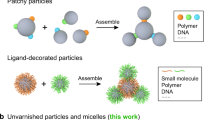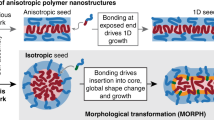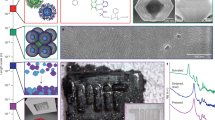Abstract
The concept of hierarchical bottom-up structuring commonly encountered in natural materials provides inspiration for the design of complex artificial materials with advanced functionalities1,2. Natural processes have achieved the orchestration of multicomponent systems across many length scales with very high precision3,4, but man-made self-assemblies still face obstacles in realizing well-defined hierarchical structures5,6,7,8,9,10,11. In particle-based self-assembly, the challenge is to program symmetries and periodicities of superstructures by providing monodisperse building blocks with suitable shape anisotropy or anisotropic interaction patterns (‘patches’). Irregularities in particle architecture are intolerable because they generate defects that amplify throughout the hierarchical levels. For patchy microscopic hard colloids, this challenge has been approached by using top-down methods (such as metal shading or microcontact printing), enabling molecule-like directionality during aggregation12,13,14,15,16. However, both top-down procedures and particulate systems based on molecular assembly struggle to fabricate patchy particles controllably in the desired size regime (10–100 nm). Here we introduce the co-assembly of dynamic patchy nanoparticles—that is, soft patchy nanoparticles that are intrinsically self-assembled and monodisperse—as a modular approach for producing well-ordered binary and ternary supracolloidal hierarchical assemblies. We bridge up to three hierarchical levels by guiding triblock terpolymers (length scale ∼10 nm) to form soft patchy nanoparticles (20–50 nm) of different symmetries that, in combination, co-assemble into substructured, compartmentalized materials (>10 μm) with predictable and tunable nanoscale periodicities. We establish how molecular control over polymer composition programs the building block symmetries and regulates particle positioning, offering a route to well-ordered mixed mesostructures of high complexity.
This is a preview of subscription content, access via your institution
Access options
Subscribe to this journal
Receive 51 print issues and online access
$199.00 per year
only $3.90 per issue
Buy this article
- Purchase on Springer Link
- Instant access to full article PDF
Prices may be subject to local taxes which are calculated during checkout




Similar content being viewed by others
References
Whitesides, G. M. & Grzybowski, B. Self-assembly at all scales. Science 295, 2418–2421 (2002)
Studart, A. R. Towards high-performance bioinspired composites. Adv. Mater. 24, 5024–5044 (2012)
Fratzl, P. & Weinkammer, R. Nature’s hierarchical materials. Prog. Polym. Sci. 52, 1263–1334 (2007)
Mann, S. Self-assembly and transformation of hybrid nano-objects and nanostructures under equilibrium and non-equilibrium conditions. Nature Mater. 8, 781–792 (2009)
Glotzer, S. C. & Solomon, M. J. Anisotropy of building blocks and their assembly into complex structures. Nature Mater. 6, 557–562 (2007)
Quan, Z. & Fang, J. Superlattices with non-spherical building blocks. Nano Today 5, 390–411 (2010)
Wang, T. et al. Self-assembled colloidal superparticles from nanorods. Science 338, 358–363 (2012)
Grzelczak, M., Vermant, J., Furst, E. M. & Liz-Marzán, L. M. Directed self-assembly of nanoparticles. ACS Nano 4, 3591–3605 (2010)
Nie, Z. et al. Self-assembly of metal-polymer analogues of amphiphilic triblock copolymers. Nature Mater. 6, 609–614 (2007)
Liu, K. et al. Step-growth polymerization of inorganic nanoparticles. Science 329, 197–200 (2010)
Cui, H., Chen, Z., Zhong, S., Wooley, K. L. & Pochan, D. J. Block copolymer assembly via kinetic control. Science 317, 647–650 (2007)
Chen, Q. et al. Supracolloidal reaction kinetics of Janus spheres. Science 331, 199–202 (2011)
Chen, Q., Bae, S. C. & Granick, S. Directed self-assembly of a colloidal kagome lattice. Nature 469, 381–384 (2011)
Wang, Y. et al. Colloids with valence and specific directional bonding. Nature 491, 51–55 (2012)
Kaufmann, T. et al. ‘Sandwich’ microcontact printing as a mild route towards monodisperse Janus particles with tailored bifunctionality. Adv. Mater. 23, 79–83 (2010)
Chen, Q., Bae, S. C. & Granick, S. Staged self-assembly of colloidal metastructures. J. Am. Chem. Soc. 134, 11080–11083 (2012)
Li, Z., Kesselman, E., Talmon, Y., Hillmyer, M. A. & Lodge, T. P. Multicompartment micelles from ABC miktoarm stars in water. Science 306, 98–101 (2004)
Wang, X. et al. Cylindrical block copolymer micelles and co-micelles of controlled length and architecture. Science 317, 644–647 (2007)
Schmelz, J., Schedl, A. E., Steinlein, C., Manners, I. & Schmalz, H. Length control and block-type architectures in worm-like micelles with polyethylene cores. J. Am. Chem. Soc. 134, 14217–14225 (2012)
Gädt, T., Ieong, N. S., Cambridge, G., Winnik, M. A. & Manners, I. Complex and hierarchical micelle architectures from diblock copolymers using living, crystallization-driven polymerizations. Nature Mater. 8, 144–150 (2009)
Kubowicz, S. et al. Multicompartment micelles formed by self-assembly of linear ABC triblock copolymers in aqueous medium. Angew. Chem. Int. Ed. 44, 5262–5265 (2005)
Gröschel, A. H. et al. Facile, solution-based synthesis of soft, nanoscale Janus particles with tunable Janus balance. J. Am. Chem. Soc. 134, 13850–13860 (2012)
Gröschel, A. H. et al. Precise hierarchical self-assembly of multicompartment micelles. Nature Commun. 3 710, http://dx.doi.org/10.1038/ncomms1707 (2012)
Li, Z., Hillmyer, M. A. & Lodge, T. P. Control of structure in multicompartment micelles by blending μ-ABC star terpolymers with AB diblock copolymers. Macromolecules 39, 765–771 (2005)
Fang, B. et al. Undulated multicompartment cylinders by the controlled and directed stacking of polymer micelles with a compartmentalized corona. Angew. Chem. Int. Ed. 48, 2877–2880 (2009)
Rupar, P. A., Chabanne, L., Winnik, M. A. & Manners, I. Non-centrosymmetric cylindrical micelles by unidirectional growth. Science 337, 559–562 (2012)
Chen, Q., Yan, J., Zhang, J., Bae, S. C. & Granick, S. Janus and multiblock colloidal particles. Langmuir 28, 13555–13561 (2012)
Sacanna, S., Irvine, W. T. M., Chaikin, P. M. & Pine, D. J. Lock and key colloids. Nature 464, 575–578 (2010)
Bates, F. S. et al. Multiblock polymers: panacea or Pandora’s box? Science 336, 434–440 (2012)
Bowden, N., Terfort, A., Carbeck, J. & Whitesides, G. M. Self-assembly of mesoscale objects into ordered two-dimensional arrays. Science 276, 233–235 (1997)
Auschra, C. & Stadler, R. Synthesis of block copolymers with poly(methyl methacrylate): P(B-b-MMA), P(EB-b-MMA), P(S-b-B-b-MMA) and P(S-b-EB-b-MMA). Polym. Bull. 30, 257–264 (1993)
Giebeler, E. & Stadler, R. ABC triblock polyampholytes containing a neutral hydrophobic block, a polyacid and a polybase. Macromol. Chem. Phys. 198, 3815–3825 (1997)
Walther, A., André, X., Drechsler, M., Abetz, V. & Müller, A. H. E. Janus discs. J. Am. Chem. Soc. 129, 6187–6198 (2007)
Schacher, F., Yuan, J., Schoberth, H. G. & Müller, A. H. E. Synthesis, characterization, and bulk crosslinking of polybutadiene-block-poly(2-vinyl pyridine)-block-poly(tert-butyl methacrylate) block terpolymers. Polymer 51, 2021–2032 (2010)
Ruckdäschel, H. et al. Compatibilisation of PPE/SAN blends by triblock terpolymers: correlation between block terpolymer composition, morphology and properties. Polymer 47, 2772–2790 (2006)
Majewski, A. P. et al. Dual-responsive magnetic core−shell nanoparticles for nonviral gene delivery and cell separation. Biomacromolecules 13, 857–866 (2012)
Acknowledgements
We thank O. Ikkala and E. Kumacheva for discussions and comments on the manuscript, and A. Majewski for providing maghemite nanoparticles. This work was supported by Deutsche Forschungsgemeinschaft within Sonderforschungsbereich 840 (TP A1 and A2).
Author information
Authors and Affiliations
Contributions
A.H.G. initiated the project. A.H.G. and T.I.L. performed experiments and collected data. A.H.G., A.W. and A.H.E.M. designed the experiments, discussed results and wrote the manuscript. F.H.S. co-designed experiments, discussed results and commented on the manuscript. H.S. provided polymers, discussed results and commented on the manuscript. A.H.E.M. supervised the project.
Corresponding authors
Ethics declarations
Competing interests
The authors declare no competing financial interests.
Extended data figures and tables
Extended Data Figure 1 Experimental approach to prepare colloidal co-assemblies exemplified on s-SBM and SDMS.
a, First, the triblock terpolymers are dispersed separately in DMAc as a non-solvent for B and D, equalling bottom-up structuring of CBBs with different cores (B and D), yet identical ‘sticky’ S patch and stabilizing M corona. b, Both colloidal dispersions are mixed in specific ratios and stirred overnight to ensure homogeneous distribution. c, Co-dialysis into a non-solvent for the S patches induces collapse and aggregation. SDMS grows into extended linear colloidal polymers decorated by s-SBM units (M corona omitted for clarity). d, Final colloidal co-assemblies stabilized by the common M corona.
Extended Data Figure 2 Compartment sizes, polymer chains per CBB and CBB mixing ratios.
a, SBM with VS/VB = 1.70 and SDM with VS/VD = 0.68 result in b, monovalent SBM (Janus) and divalent SDMS units, respectively. CBBs are visualized after crosslinking of the remaining double bonds within the particle cores. c, Examples of spherical SBM clusters and linear SDMS colloidal polymers. d, Diagrams of CBB compartment volumes and surface area of associative patches. We determine the number of SBM units able to attach to the –S– segments of the SDMS colloidal polymers by calculating the volume and the diameter of the CBBs, assuming a spherical shape of B and S phases and considering the number of polymer chains per patch. The spherical SBM units are composed of (i) the body as the sum of the collapsed S patch (grey) and B core (black) and (ii) the M corona patch. The radius, RCBB, and the volume, VCBB, displaced by the CBB when aggregating into the –S– segments are estimated by combining the volume of S plus half of the volume of B (the dashed line marks RCBB). These assumptions are valid for the collapsed state, given the unfavourable interactions with the surrounding medium and the minimization of the interfacial energies.
Extended Data Figure 3 Loading capacity for decoration with spherical CBBs during co-assembly.
SDMS and s-SBM colloidal co-assemblies with increasing mixing ratios 2:1, 4:1, 8:1 and 35:1 of s-SBM:SDMS and corresponding co-assembly composition. a, At small excess, s-SBM:SDMS = 2:1, the –S– segments are only partly decorated. b, c, With increasing CBB ratio, the –S– segments of the colloidal polymers are more strongly occupied (4:1) (b) and at full capacity in a radial manner (8:1) (c). d, Above this ratio, no space remains on the colloidal polymer and only then does s-SBM start to form homo-clusters (35:1; football-like or raspberry-like homo-clusters adjacent to the colloidal co-assemblies). These observations fit well with our calculations, as a cylinder with d–S– ≈ 55 nm and w ≈ 24 nm can accommodate up to nine s-SBM units with dCBB ≈ 19 nm (πd-s- ≈ 173 nm; 173 nm/19 nm ≈ 9.1). Scale bars in insets are 200 nm (OsO4 staining: S grey, B dark grey dots, D black, and M not visible as a result of degradation by the electron beam.)
Extended Data Figure 4 Co-assembly of s-SBM(y) and SDMS in dependence on the corona volume of the monovalent s-SBM(y) units (y stands for s, m or l).
Colloidal co-assembly occurs preferentially with matching onsets of aggregation that depend on the corona volume, which is tunable either by decreasing the block length of the corona block, rM = VM/(VS + VB), rM(s-SBM(l)) = 0.74, rM(s-SBM(m)) = 0.34, rM(s-SBM(s)) = 0.15, or by reducing the solvent quality, here the addition of propan-2-ol from 10 vol% to 40 vol%. Thereby, crosses indicate no co-assembly, circles the onset of co-assembly and tick marks effective and quantitative co-assembly. For detailed discussion see Methods. (OsO4 staining: S grey, B dark grey dots, D black, and M not visible as a result of degradation by the electron beam.)
Extended Data Figure 5 Timeline of CBB aggregation and response of CBB constituents on solvent composition.
a, Co-dialysis of CBBs (here SDMS and s-SBM(y)) from DMAc (squares) into acetone (circles)/propan-2-ol (triangles) mixtures (60:40 v/v) results in a continuous change of a multitude of polymer–polymer interactions as well as polymer block responses to the ternary solvent mixture. With progressing dialysis, DMAc is replaced by acetone/propan-2-ol, affecting the solubility of S/M corona patches. This induces the collapse into S patches and determines the onset of aggregation. Time-dependent 1H-NMR measurements were performed by drawing samples at specific intervals during dialysis to determine the solvent composition. b, TEM series exemplifying the timeline of aggregation on s-SBM(l) and SDMS. Up to 30 min, S corona collapses to form S patches, yet both CBBs are still stable due to stabilizing corona; after 30 min, SDMS (smaller M corona) aggregate; after 45 min, aggregation of SDMS proceeds, while s-SBM(l) is still stable (larger M corona, no co-assembly); at 60 min, s-SBM(l) aggregates and co-assembly takes place; up to 90 min, co-assembly is complete. (OsO4 staining: S grey, B dark grey dots, D black, and M not visible as a result of degradation by the electron beam.)
Extended Data Figure 6 Supporting images of colloidal co-assemblies composed of SDMS and s-SBM, m-SBM and l-SBM.
a, Optical microscopy image of colloidal co-assemblies 30 μm in length. b, c, TEM images of fully decorated –S– segments with s-SBM. d, e, Larger m-SBM units induce kinks due to lateral, alternating decoration and high volume displacement within the –S– segments. f, Zoom-out of rod-like colloidal oligomers end-capped with l-SBM. g, Magnification of f. h, The smallest possible co-assembly with [SDMS]1; that is, two end-caps attached to one SDMS unit. (OsO4 staining: S grey, B dark grey dots, D black, and M not visible as a result of degradation by the electron beam.)
Extended Data Figure 7 Length control of colloidal polymers via end-capping with l-SBM.
a, Without any l-SBM end-capper added, the SDMS units grow into remarkably extended superstructures several micrometres in length, exceeding 500–600 SDMS repeating units. The inset illustrates the segmented core and some occurrence of branching. The displayed image consists of an overlay of nine separate TEM images, because the superstructure was far too large for magnifications that were still able to resolve the nanostructure. The dashed box marks the part of the colloidal polymer that is shown in Fig. 3d. b, TEM images and frequency distributions (red bars) of 500 evaluated colloidal polymers for varying SDMS to l-SBM mixing ratios of 40:2, 20:2, 10:2 and 5:2. Scale bars, 5 μm. We count segments and multiply the resulting average value by the average segment length, Ln = 55 nm, to yield the average length of the co-assembly. Data are plotted against the normalized frequency and fitted by a Schulz–Flory frequency distribution (squares), F(L) = exp(−L/Ln)/Ln, showing a continuous decrease in the average length coinciding with the mixing ratio. The similar timescales of onset of aggregation combined with matching sizes of CBBs both promote efficient end-capping.
Extended Data Figure 8 Stability of [SDMS]m colloidal polymer versus SBT/[SDMS]m co-assembly in polar solvents.
Photograph of two colloidal solutions after dialysis into ethanol. Left: instant precipitation of the [SDMS]m colloidal homopolymer as a result of complete collapse of the M corona. Right: the SBT/[SDMS]m colloidal co-assembly is stabilized by the soluble T corona patches. Precipitation is not observed even after weeks.
Extended Data Figure 9 Colloidal molecules and two-dimensional network formation.
a, Co-assembly of four SBM with one SDTS CBB by means of collapsing S patches in acetone/propan-2-ol (60:40 v/v) yields colloidal molecules with one or two end-caps of the (SBM)2-(SDTS)-(SBM)2 type, permitting three or four nearest neighbours at every linking point in large-area networks. b, Co-assembly of six SBM with one SDTS CBB by means of collapsing S patches in acetone/propan-2-ol (60:40 v/v) yields colloidal molecules of the (SBM)3-(SDTS)-(SBM)3 type. c, Addition of propan-2-ol until acetone/propan-2-ol reached 20:80 (v/v) selectively collapses the terminal M corona, allowing two nearest neighbours at every linking point of the network in solution. On some occasions the network takes on the form of a distorted kagome lattice.
Rights and permissions
About this article
Cite this article
Gröschel, A., Walther, A., Löbling, T. et al. Guided hierarchical co-assembly of soft patchy nanoparticles. Nature 503, 247–251 (2013). https://doi.org/10.1038/nature12610
Received:
Accepted:
Published:
Issue Date:
DOI: https://doi.org/10.1038/nature12610
This article is cited by
-
Synthesis of branched silica nanotrees using a nanodroplet sequential fusion strategy
Nature Synthesis (2023)
-
Long-Range Ordered Nanostructures of Assembling Macromolecules via Rational Design of Kinetic Pathways: A Computational Perspective
Chinese Journal of Polymer Science (2023)
-
Controlled Fabrication of Uniform Digital Nanorods from Precise Sequence-Defined Amphiphilic Polymers in Aqueous Media
Chinese Journal of Polymer Science (2023)
-
Symmetry-breaking in patch formation on triangular gold nanoparticles by asymmetric polymer grafting
Nature Communications (2022)
-
Polymer cyclization for the emergence of hierarchical nanostructures
Nature Communications (2021)
Comments
By submitting a comment you agree to abide by our Terms and Community Guidelines. If you find something abusive or that does not comply with our terms or guidelines please flag it as inappropriate.



